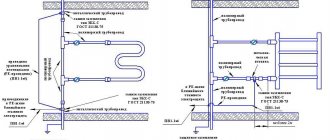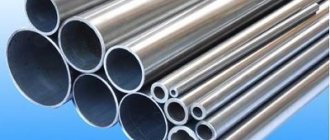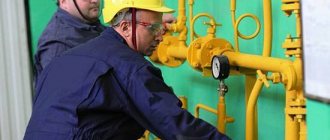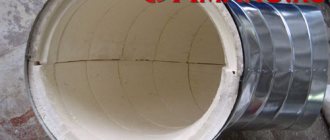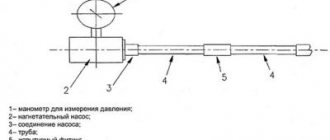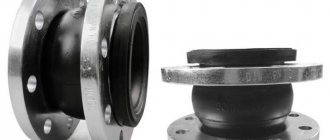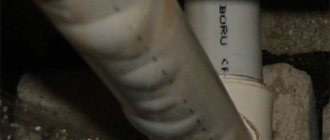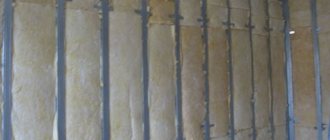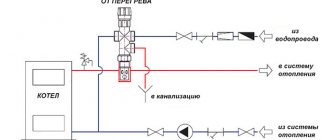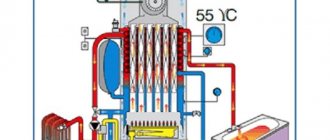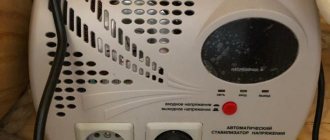Metal pipes are used everywhere, they are used to install drains, lay all kinds of communications, install load-bearing structures and many other uses.
Metal products are strong, durable and, if properly used, can last for decades. But they have the only significant drawback: they are susceptible to corrosion.
People often try to protect water supply and wastewater systems by covering them with ordinary oil-based paint, but this usually does not help; after a short time, the paint peels off, falls off, and these systems are again fully exposed to external aggressive factors.
In order to extend the service life of the above systems for a sufficiently long time, they must not only be painted, but completely processed and a primer must be applied.
Why prime pipes?
Using primer before painting has a number of positive aspects.
Metal products are usually treated with mixtures that have anti-corrosion properties, which can very well smooth the prepared surface, guarantee a completely even paint coating, and also avoid the appearance of rust.
It also provides a noticeable increase in the adhesion of the primed base to the paint.
Costs for construction work are reduced, since after applying the primer, the consumption of enamel or varnish for painting water supply and drainage systems is significantly reduced.
The primer can balance the difference in temperature coefficients of liquids passing through a metal pipe and the environment, creating increased stability of the coating and providing its protection.
Subtleties of the processing process
Application of primer to metal pipes and heating radiators occurs in the same way as to other surfaces, but has some features:
- The surface is thoroughly cleaned of old paint and rust until it shines. For this purpose it is better to use metal brushes. When cleaning hard-to-reach areas of heating radiators, you can use metal brushes.
- If a layer of old paint does not come off well, then you need to use a special softening solution, which is applied to pipes and heating radiators and covered with a film. After waiting a little time, excess layers can be easily removed with a spatula.
- After this, the work area must be thoroughly cleaned with sandpaper, gradually changing its grain size to a finer one, and cleaning the metal until shiny and smooth.
- Rinse and let dry.
- Treat dried products with white spirit or any other suitable degreaser and dry.
The next step is to begin applying the primer. Depending on the size of the surface and the composition of the primer mixture, it is applied:
- With a brush. The brush provides a more thorough treatment of uneven surfaces, but on large flat areas (for example, thin long pipes) it takes a long time to work with it and the material consumption is high.
- Rollers of different sizes. The use of small rollers in small areas significantly reduces the consumption of the protective composition.
- With a spray gun.
Priming occurs in several layers. The first is applied very thinly, filling small irregularities and cracks.
After it dries, another 1-3 layers are added if necessary. The primer consumption will decrease with each new layer.
It is advisable to carry out the processing process on products at room temperature. Heating radiators should be turned off temporarily. This will ensure uniform drying, increase the quality of work and reduce primer consumption.
Decorative paint and varnish coatings will lie perfectly smoothly on the surface treated in this way, without drips or streaks, providing the pipe with additional protection from moisture and temperature changes and significantly extending its service life. If you take the time and correctly carry out all the processing steps before painting, then the plumbing and heating systems will not require replacement for a long time.
Primer for pipes is a mandatory processing step, which allows the future coating to be well fixed and to provide protection against corrosion. The primer is chosen depending on the purpose of the pipe, be it a radiator or a gas pipeline.
How to choose the right primer
When preparing to paint and before purchasing a primer to protect your metal pipes, there are some very important things to consider.
If the pipes are intended for central heating radiators, they will be subject to significant temperature changes; cold water supply pipes will constantly have a cold and damp surface; metal pipes for distributing hot water; they are constantly exposed to high temperatures; dry metal pipes for supplying gas outdoors: it is necessary to take into account the influence of external factors (weather, atmospheric conditions).
Types of metal corrosion
There are two main types of corrosion, differing in the degree of damage that it can cause. A distinction is made between direct and indirect corrosion.
If corrosion has caused direct damage, in this case the metal coating cannot be restored. Therefore, you will have to change all equipment that consists of metal parts. If corrosion has already damaged the metal, it is best to provide anti-corrosion protection. It, in turn, costs a lot of money, but after treatment with special substances and chemical solutions, the renewed metal coating will no longer be subject to oxidation and destruction from corrosion.
For this reason it costs a lot of money. However, after treatment with special substances and chemical solutions, the renewed metal coating will no longer be subject to oxidation and destruction from corrosion.
If the damage was indirect, only some parts of the metal structure are replaced.
In this case, funds will be spent on:
- purchase of appropriate metal,
- reduction in equipment power if the metal structure consists of pipes and other similar equipment,
- improvement of products, the main element of which is a metal frame.
Corrosion protection is the main task of modern designers developing various metal parts. In order for a structure to last for several decades, it is necessary to create all the conditions to protect it from external factors and various atmospheric phenomena, and the ability to influence the structure of the metal.
Modern technologies make it possible to develop an anti-corrosion coating for steel pipes, which provides the metal structure with additional protection from chemical elements that often come into contact with its surface.
What types of soils are used
In order to protect the product well and maximize the time of effective use, the primer is selected based on operating conditions:
- Insulating primers. They are prepared from conventional mixtures of paints (red lead, white lead) using specific additives, in particular epoxy resins. When applied to the surface to be treated, they form a stable thin coating that insulates the product from atmospheric influences. Mainly used for pipes running outdoors.
- Phosphating type, two-component primers. They are made from several active ingredients that increase the passivation of steel and phosphoric acid, are intended for servicing any metal pipes, and have good adhesion to the base and coating. Typically used before applying any paint and varnish mixtures, reducing the amount of material used and improving corrosion protection. Passivating primers change the electrochemical properties of the surface of the product, preventing the formation of rust. The composition allows you to protect the pipe, even if moisture penetrates under the applied coating. Recommended for use on damp pipes.
- A primer protector is a solution of a metal suspension in a paint and varnish material. When dry, it creates a thin metal coating that well protects the treated surface.
- Inhibitors. Manufactured on the basis of water-based and oil-based enamels, they prevent rust for a long time and are a new generation of protection. Designed to protect wet pipes and outdoor pipes.
- Primer-converter (for rust) based on phosphoric acid. The primer converts iron oxide into its phosphate, which creates a practically insoluble film on the surface of the product. This reaction can, to some extent, restore the corrosion damage.
Internal and external epoxy coating of pipes and piping parts
Cost of work
5,000 rubles
Submit an application ×
Purpose of epoxy coating
1. Protect against corrosion. Internal and external epoxy coating of pipes provides high resistance to moisture and salt deposits. Treated pipelines are able to withstand the transportation of media of varying degrees of aggressiveness.
2. Reduce surface roughness and increase throughput. Epoxy treatment of pipes and pipe parts also helps reduce hydraulic resistance.
What is it used for?
- Pipelines, including:
- Gas pipelines
- Oil pipelines
- Water pipelines
- Heat pipes
- Pipeline accessories:
- Bends
- Tees
- Transitions
- Stubs
- Bottoms
Epoxy Coating Materials
We treat the internal and external surfaces of pipes and pipeline elements with protection based on epoxy resin. The internal epoxy coating of pipes promotes the formation of a film that is highly hard and elastic and has no seams. We produce internal coating of pipelines using the following materials:
- Epoxy coating Amercoat 391PC Mainly used in the oil industry, as it is characterized by resistance to shock loads and aggressive environments. Does not contain solvent, can be used when working with hot water.
- Epoxy coating Amercoat 240 Characterized by a low solvent content, primarily used for treating welded joints. The protection is used for the internal coating of tees, transitions, plugs and other connecting elements.
- TREPP TR-90 enamel is a high-quality coating of the inner surface of pipes against corrosion and ensures the possibility of their operation when working with media such as oil, water, oil and gas mixtures. The internal enamel coating of the pipes allows working with flows with temperatures from −60°C to +90°C.
- Protective paint PEP-585 Allows for the safe transportation of oil and drinking water, the temperature of which can vary from −50°C to +60°C.
Epoxy coating according to TU 1469-002-99294060-2016, developed by , provides durable protection against pipeline corrosion, protects against the aggressive effects of chemicals, and also increases the service life of the pipeline network.
Popular goods
- Polymeron - urethane enamel for metal 38 RUR.
- Nerzhalux - industrial paint for metal (thick layer) 52 rub.
- Zinconol-2Sh - cold galvanizing system for metal with electrochemical protection 90 rub.
- Tsikrol-Aqua - quick-drying odorless primer-enamel for galvanized metal 64 rub.
How to get rid of corrosion
In order for a metal structure to last longer, it is necessary to treat the coating with special substances to prevent the formation of corrosion on the surface of the material.
The most common are pipes with an internal anti-corrosion coating, because thanks to the protective layer, they last longer. Special chemicals, which will subsequently protect metal pipes, are applied to their inside. Moreover, if corrosion provokes rust on the outer surface of the pipe, preventing its spread will be more difficult. In this case, manufacturers try to worry about the safety of the entire surface of the pipe in advance.
Therefore, the cost of such equipment, consisting of several metal parts, will be significantly higher. Manufacturers indicate on the accompanying instructions for the product that special protective substances are applied to the metal.
If there is no such protection, the pipe can last for several years until external factors acting on its surface lead to partial or complete destruction of the metal.
In this case, it does not matter where the pipe is located indoors or outdoors. Even if it is part of communications and is located in sea water, its surface is exposed to various chemicals.
The following are especially in need of corrosion protection:
- various types of pipelines located not only in the open air, but also in water,
- equipment, the main part of which is metal,
- metal frames of various residential premises and industrial buildings,
- all kinds of tanks,
- construction cranes,
- bridges,
- heat exchangers.
There are also pipes with an external anti-corrosion coating, created specifically for subsequent installation in enterprises and industrial workshops, where most of the basic chemical reactions and processes that speed up the production of goods often occur.
External protection of pipes from corrosion is as important as internal protection. However, if the manufacturer does not have additional financial resources to purchase the appropriate equipment, you can save significant financial resources by purchasing this type of pipe. Russia is currently investing heavily in the development and subsequent production of special substances that protect pipes from rust and other signs of corrosion on their surface.
Some regions of Russia have a humid climate. This is an ideal place for not only rust to appear on the walls of metal coatings, but also as a result of corrosion, which completely destroys metal coatings of any thickness and shape. If we take into account all the above factors, at the moment corrosion is the main problem that does not allow our country to develop fully. When our specialists are able to establish the production of special substances designed for anti-corrosion protection of metal surfaces, the state will save significant financial resources, which are spent annually on the purchase of such chemical compounds abroad.
In addition, there is no need to replace pipes and other metal coatings over time, the service life of which expires due to rust and corrosion that destroys their surface.
The use of anti-corrosion protection products can significantly reduce material losses in most developed countries of the world.
At the same time, Russia needs to take its place among producers of such goods. This will allow our country to take a leading position not only in the production of necessary goods and chemical elements that prevent the destruction of metal surfaces. In this way, it will be possible to conclude a sense of mutually beneficial contracts that will allow Russia to cooperate with other states.
There are several ways to apply an anti-corrosion protective coating to a metal surface. The most common is the barrier method of processing metal surfaces. That is, the substance is applied directly to the coating surface itself. Even if it contains additional chemicals, the anti-corrosion protection will fulfill all the functional characteristics and properties assigned to it. For example, if a metal surface is painted with some kind of paint and varnish material or contains impurities of other substances and materials such as nylon, the substance will not enter into various chemical reactions with them, but will retain a strong structure.
Just as paint and varnish materials create a protective film on the surface of the material, anti-corrosion substances form an additional coating, which in turn is not washed off with water. Over time, even such anti-corrosion substances lose their properties. Therefore, over time it is necessary to repeat the processing procedure.
However, before choosing certain means to protect a metal surface, it is also necessary to take into account the characteristics of the metal itself. Even the conditions under which the process of applying a substance to metal occurs plays an important role for its further operation and performance.
Therefore, Russian manufacturers are seriously thinking about creating an effective, inexpensive product for protecting metal surfaces from damage and all sorts of consequences of corrosion.
Technologists have already achieved certain results by developing several universal compositions that interact with most metals. But they still need to be refined and further improved. Subsequently, these compositions and substances will provide complete protection to pipes and other metal structures.
Operating temperature conditions
When choosing the heat resistance of the primer and the paint coating applied to it, it is important to take into account the temperature of the pipe. Up to 60°C. In most cases, this soil is well suited for central heating batteries and hot water supply.
As a primer for protection, in full compliance with the requirements at all stages of preparation, insulating primers are usually used. They reduce paint consumption, allow you to get a smooth surface and avoid fading and peeling.
Up to 100°C. These primers are mainly used more often in private households, since the owners set the heating temperature themselves, and the radiators can heat up above 60°C.
The primer can be used as in the previous case, but the paint coating must be selected with pigments that can not fade in this temperature range.
There are also primers that can withstand temperatures above 300°C. They are used exclusively in industrial enterprises.
When purchasing a suitable mixture from a retail chain, you need to check the material consumption. Typically it will be approximately 100 grams per square meter.
Pipes with protective coating
Since at the moment oil and gas are becoming increasingly popular as universal types of fuel, it is worth thinking about how to provide high-quality transportation for them.
Therefore, it is important to create pipes at enterprises that would be protected with a special anti-corrosion coating that prevents the destruction of pipe walls or the occurrence of corrosion on their surface, which leads to their destruction.
Projects are being created that would be designed to improve energy security in a particular country. We can say that in our time the world is experiencing an industry boom in pipeline transport. Thus, a situation has been created that allows for the construction of pipeline systems that could become an alternative to the existing ones.
Russia is a rapidly developing country that is trying to invent and develop new and advanced types of protective coatings. Surprisingly, our specialists have already created pipes containing polyethylene insulation.
It is important to be aware of the fact that the installation of such pipes can only be carried out efficiently by a professional who understands such issues.
It is no secret that technologies that provide solutions to such problems were invented several decades ago. If the pipe has a 3-layer polymer insulation consisting of several layers, then the insulation of the pipe joints should be similar. The only type of this type of insulation will be heat-shrinkable cuffs.
